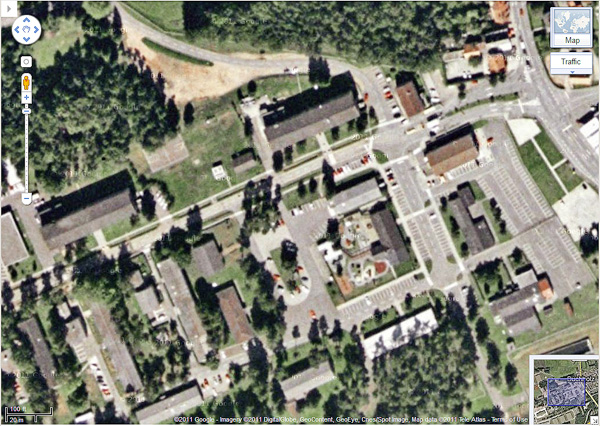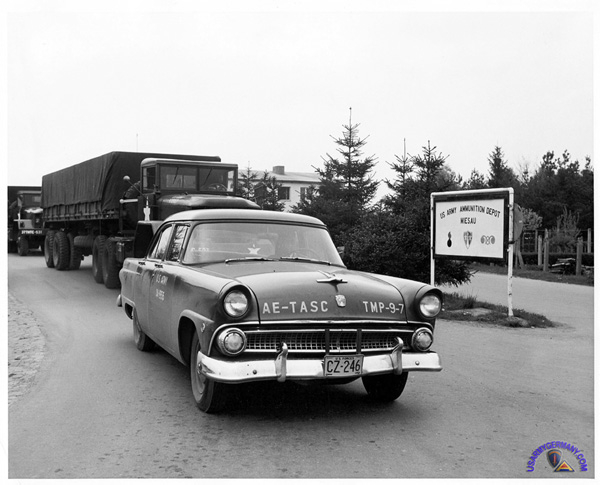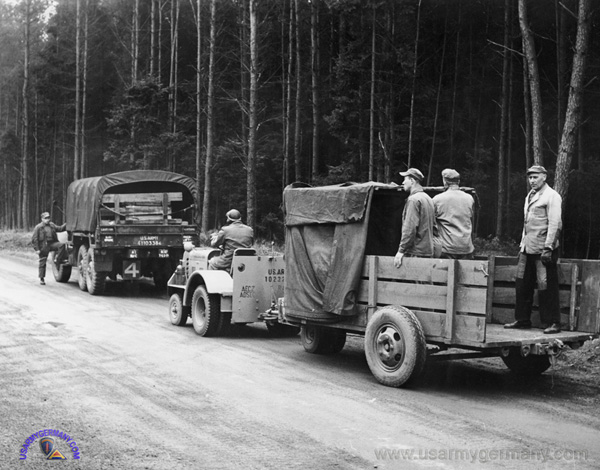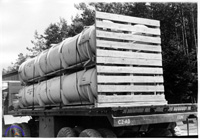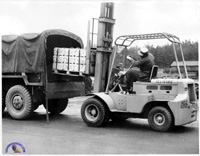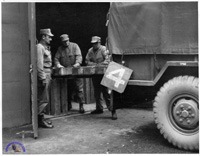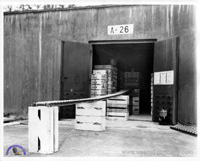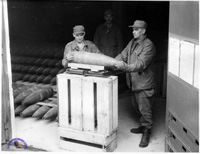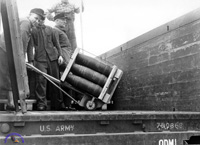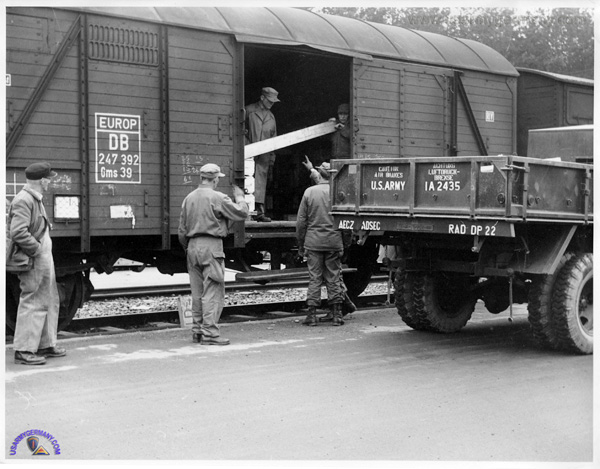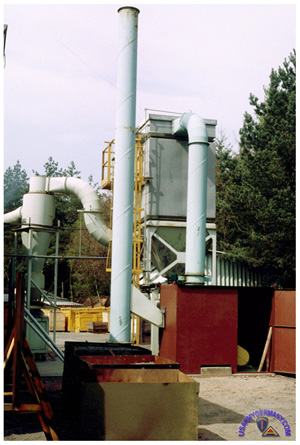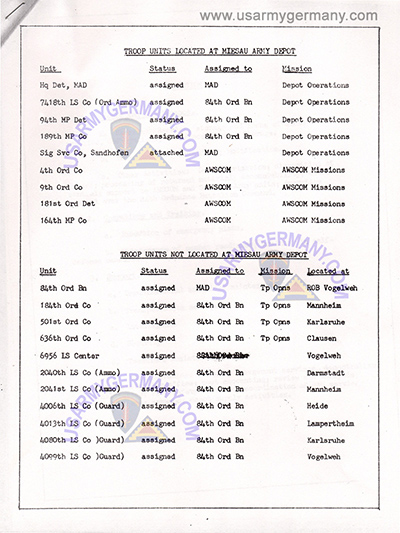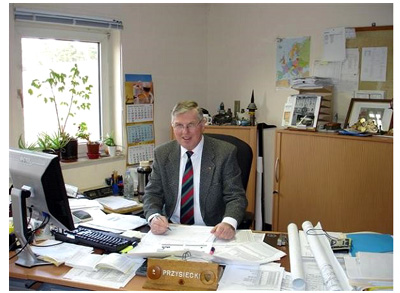| If you do
NOT see the Table of Contents frame to the left of this page, then
Click here to open 'USArmyGermany' frameset |
|||
|
Miesau Ammunition Depot |
|||
|
|
|||
|
|||
|
|
|||
| Depot History | |||
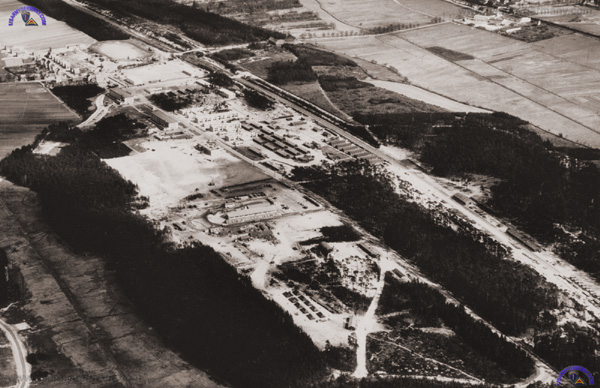 1953 aerial view of the Rhine Ammunition Depot at Miesau (Webmaster's collection) (If you have additional maps, photos or information on the Ammunition Depot at Miesau from the 1950s-1980s, I would like to hear from you! Falls Sie ein deutscher Angestellter waren oder bei der Labor Service gedient haben, können Sie auch gerne auf deutsch schreiben.) |
|||
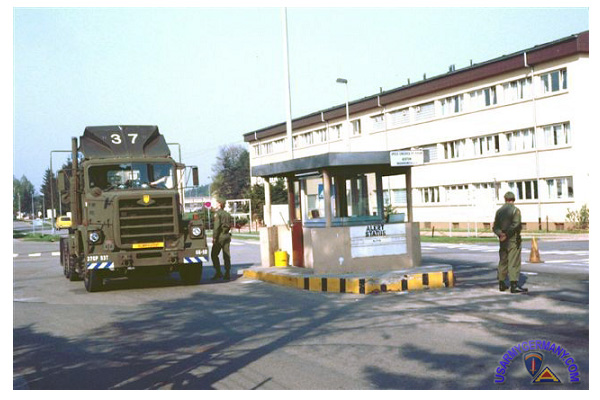 Main gate in 1980 (Bogdan Przysiecki) |
|||
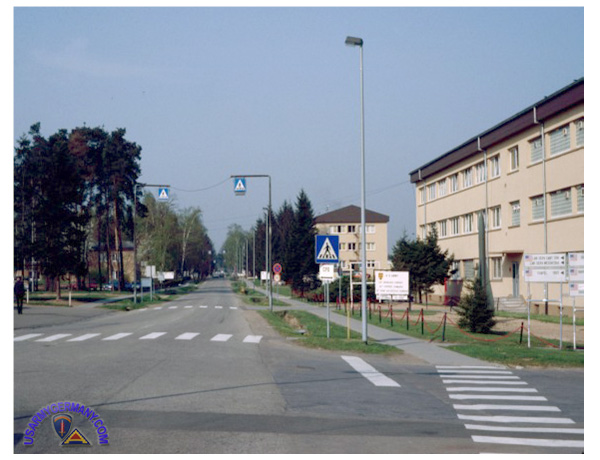 Looking from main gate down Johnson Road, the main road within the depot (Bogdan Przysiecki) |
|||
| 1950s | |||
| 1963 | |||
| (Source: STARS & STRIPES, September 26, 1963) | |||
|
|||
| Safety is paramount: the entrance of the building and the rear area are off limits when the furnace is being operated. Men loading shells into the hopper (which feeds the conveyor belt) work in an anteroom that only has a small opening into the main furnace room - just large enough to admit the conveyor belt. About 50,000 tons of ammunition for use by 7th Army units passes through Miesau Ammo Depot every year. The explosives arrive from the US (Webmaster note: at various European ports, but primarily at the port of Nordenham near Bremerhaven) and are transported via rail or truck from the port to the depot. At the depot, the explosives are palletized into units from six to twenty-four boxes, depending on size. This simplifies the subsequent handling of the ammunition by forklifts. Outgoing shipments are stay-braced (to avoid shifting during transport) by experienced crews in the trucks tasked with transporting the ammo to its final destination in Germany or other countries. Shells that have been stored at the depot for a longer period are fluoroscoped (X-Ray) for possible defects by Army personnel. Shells showing flaws are sent to the ammunition boneyard. Sound shells are refurbished - the shell cases are cleaned and relettered; fins are checked and replaced, if necessary. |
|||
| 1968 | |||
| (Source: STARS & STRIPES, April 5, 1968) | |||
| US Army Ammunition Depot Miesau is responsible for storing a quarter of a billion dollars worth of ammunition earmarked for US Army troops in Europe. The depot's chief customer is Seventh Army in southern Germany. The depot also performs maintenance and renovation work on the stored ammunition. The depot is spread over several sites in the German Land Pfalz (Palatinate). nder depot control are 2,500 acres at Miesau, 2,500 acres at Weilerbach and another 200 acres within a 50 mile radius of Miesau. Shipping and receiving tasks are dividied between Miesau and Weilerbach. Ammo stored in the field must be checked after a specified time - it is trucked back to Miesau for inspection. Some shells are inspected using fluoroscopy; other types of ammo are inpsected using ultra-sonic vibrations. A large project at the depot currently underway is the replacement of fuse heads on 81-mm mortar shells. The new head incorporates a safety feature in which the round does not become armed until it has traveled a safe distance from the mortar. (The old head being replaced became armed just a few feet after leaving the mortar.) Miesau has a very good industrial safety record. The depot 's accident rate is 2.37 accidents per million man-hours compared to COMZ's 8.8 "guiideline" when using civilian (LN's and labor service) personnel. The "guideline" for military personnel is 2.0. Miesau's "military" accident rate is 0. |
|||
Late 1960s |
|||
(Source: Undated historical notes from Miesau Army Depot) |
|||
MISSION 1. Supply and Maintenance. 2. Operations and Training. 3. Support. |
|||
| (Source: Email from Bogdan Przysiecki, German employee, Miesau) | |||
|
|||
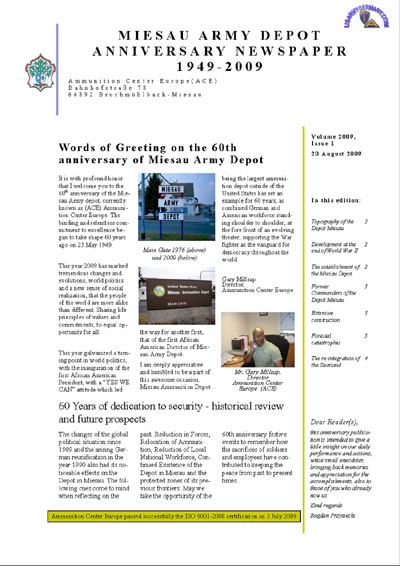 Special issue of the depot newspaper (Bogdan Przysiecki) (Depot Milestones/Chronology - pages 10-14) Start at: Page 10 - Page 20 - Page 30 - Page 40 |
|||
COMMENTS: (Source: Email from Vernon Pratt) I just finished reviewing your 60th Anniversary paper, thank you for bringing back memories. I was stationed at Miesau from 20 March, 1986 through 19 March, 1989; my unit was the 164th Military Police Company. I was surprised not to see mention of the 59th Ordnance Brigade, 9th Ordnance Battalion, or the Air Defense Company (611th I believe) mentioned in your paper timeline. While I was stationed at Miesau (NATO Site 104) the 9th Ord BN and our company (164 MP CO) were bestowed a unit award/citation for the deployment of Pershing II's from the States. The 164 MP CO was also a unique MP unit as it was larger than a typical (combat support) MP company; at the time I was with the unit we were the second largest MP CO in the U.S. Army. I have fond memories of time spent in Miesau, of particular note was the Imbiss just outside of the main gate that had the best schnitzels. I remember well the depot would host a small carnival outside the main gate and one of those days I was stuck making cotton candy for the whole day. I do not remember the Civilian Workers Canteen or it's closing but I do remember their Dining Facility which always had great food; I looked forward to the walk past the fountain pool and the gold fish it contained. So many memories in just a few short years, I would leave you with another fact about Miesau; during the REFORGER exercises Miesau was a key supplier of equipment to units coming from the States. Again, thank you for the memory trip. (Webmaster Note: You will find a lot of information on the 59th Ordnance Bde and its subordinate units on the 59th Ord Bde Page of this website.) |
|||
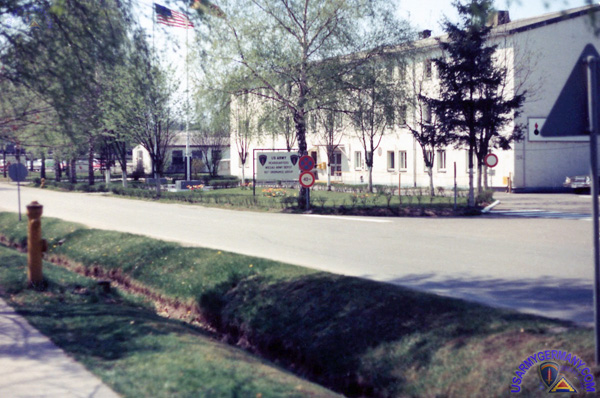 Miesau Army Depot Headquarters, 1975 (Brent Becker, 189th MP Co) |
|||
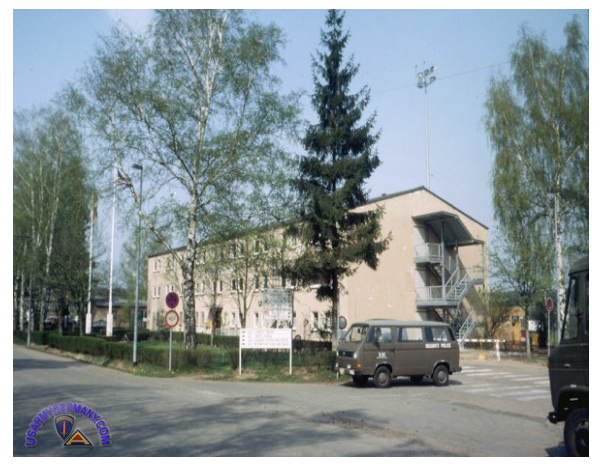 Administration building at Miesau Army Depot (Bogdan Przysiecki) |
|||
|
|
|||
| If you have more
information on the history or organization of the Miesau Ammo Depot, please contact me |
|||
|
|
|||
| 7418th Labor Service Ordnance Company | |||
| (Source: Email from Bogdan Przysiecki, German employee, Miesau) | |||
| The 7418th LS Ordnance (Company) was activated on 20 June 1949 with permanent station at the Rhine Communication Depot, presently Miesau Army Depot. During the reorganization directed by General Orders No 36, HQ USAREUR, the 8903rd LS Ammunition Renovation Platoon was merged on 1 Feb 66 into 7418 LS Ord Ammo Co. During the reorganization directed by Orders No 38, HQ USAREUR and Seventh Army, dated 9 Feb 67, the part of the 4507th LS Company transferred from Verdun (France) to US Army Ammunition Depot Miesau, was merged into 7418th. The 7418th reaching on 29 Mar 1967 the strength of 337 personnel. On 1 Sep 1968 the unit strength was decreased to 320 by General Orders No 507, HQ USAREUR and Seventh Army. Manpower Voucher 84th OB-26-73, HQ 60th Ordnance Group, dated 12 Mar 73 increased the Unit strength to 330. The Unit was assigned for operational control Miesau Army Depot and for administration control to 6956 LS Ammo & Gd Center. The mission of 7418th was shipment, receiving, rewarehousing, storage, inventory and maintenance of ammunition as directed by Commander Miesau Army Depot. |
|||
| Weilerbach Storage Area (WSA) | |||
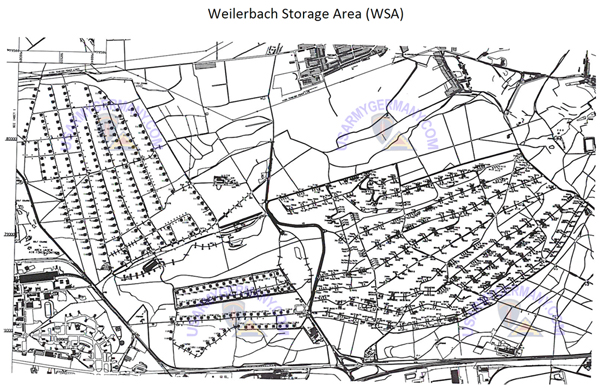 WSA Installation Map |
|||
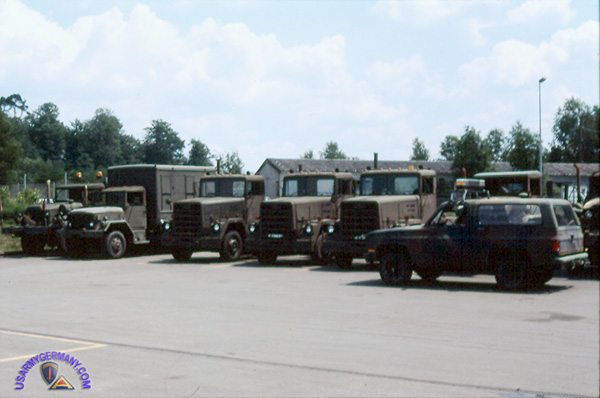 WSA motor pool |
|||
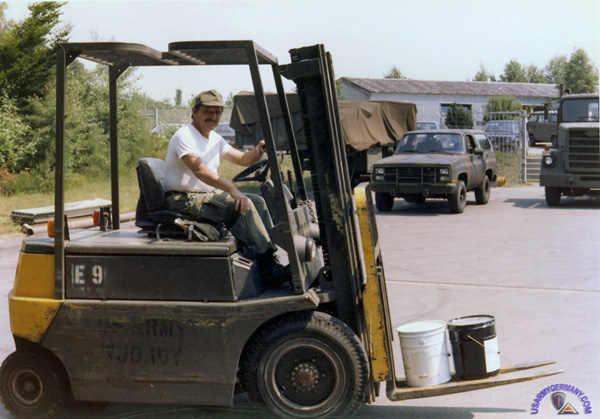 WSA motor pool |
|||
| (Source: Email from Bogdan Przysiecki, German employee, Miesau) | |||
| The official name for Weilerbach was Weilerbach Storage Area (WSA). It was extended storage space to Miesau Army Depot. At WSA were stored ammunition of USAREUR, Canadian and special weapons under control of 41st Ord Co/59th Ord Brigade. The Canadians were using 30 magazines and 40 huts in WSA and 5 magazines in Miesau. The Canadians maintained a Stock Control Office at Miesau but all work in connection with receiving, storage, shipping and inventory of ammunition was performing by personnel of Miesau Army Depot. The 41st Ord Co used 38 magazines and 2 buildings for ammunition maintenance. The remaining 197 magazines and 760 huts were used for storage of USAREUR ammunition. Miesau Army Depot had set up a separate ammunition branch, key control office and inventory crew to deal with all ammunition tasks at WSA. The personnel strength of the WSA branch was about 80 German local nationals (LN) and 7418th CSG Ord. In 1983 the storage personnel from 7418th CSG Ord were transferred to 2042nd CSG which continued the mission. WSA had a very small administrative area with one administration building, one small motor pool and a gas station -- no quarters or barracks. The next Barracks for the troops were Rhein Ordnance Barracks (ROB) at Kaiserslautern. |
|||
| Related Links: | |||

